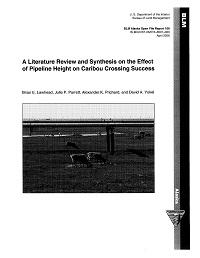A Literature Review and Synthesis on the Effect of Pipeline Height on Caribou Crossing Success

The effects of elevated pipelines on the movements of caribou (Rangifer tarandus) in Alaska have been studied since the late 1960s. The recent expansion of oil development west of the Kuparuk Oilfield raised the issue of pipeline height to prominence for local residents of Nuiqsut and other North Slope villages and prompted this review of the literature. Linear infrastructure such as pipeline/road corridors can act as obstructions that impede caribou movements but do not act as complete barriers unless they are physically impassable, such as large-diameter pipelines on or near the ground. Most of the pipelines in the Prudhoe Bay Oilfield were constructed in the 1970s before the minimum height of 1.5 m (5 ft) above ground level was stipulated by the State of Alaska. Older pipelines elevated 0.4-1.1 m above ground level in the Prudhoe Bay field constitute barriers to caribou crossings in the absence of crossing ramps. The available data on pipe-height selection by caribou demonstrate that pipelines elevated to the minimum height of 1.5 m are high enough to accommodate crossings by caribou during snow-free periods. The limited data on pipeline crossings by caribou in winter indicate that pipeline heights in the range of2.1-2.5 m (7-8 ft) are more likely to be used by caribou than are lower heights. Because of a tendency for more snow to accumulate beneath lower pipe, elevating pipelines higher than 1.5 m will decrease the risk of reduced clearance between the snow surface and the bottom of pipelines, especially in severe winters. Research in northern Alaska oilfields has confirmed that the most important factor affecting caribou crossing success at pipeline/road corridors is traffic on nearby roads. The combination of high-traffic roads (15 or more vehicles/hr) adjacent to pipelines elevated to the minimum height of 1.5 m created a synergistic effect that reduced caribou crossing success. Hence, to be as effective as possible, elevated pipelines should be separated at or beyond the recommended minimum distances of 122-152 m (400-500 ft) from roads. Separating roads from pipelines also achieves the important purpose of eliminating snow drifts under pipelines next to roads. In addition to traffic, other factors that confound evaluation of pipeline-crossing success by caribou include differences in infrastructure and study design, caribou group dynamics, insect harassment, season, habitat, topography, and habituation. Needs for further information regarding the effects of pipeline characteristics on caribou crossing success include the adequacy of 1.5-m-high pipelines in winter (to supplement the scant data available); the effects of habituation; the effects of reflectivity of pipeline sheathing and other potentially confounding factors not yet investigated, such as auditory and chemical stimuli; and the adequacy of the 1.5-m minimum height for crossings by subsistence users on snowmobiles.
